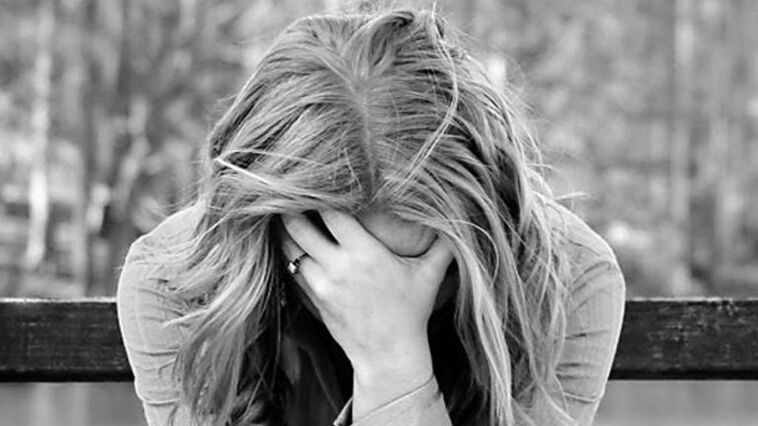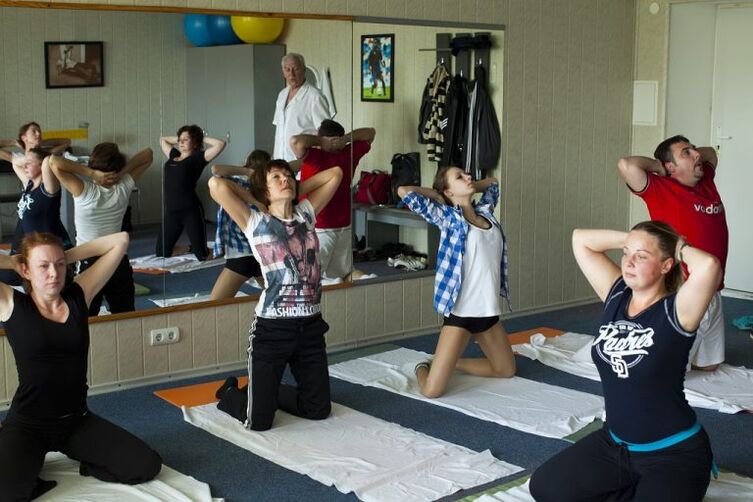Cervical osteochondrosis and dizziness, fears and depression - conditions, at first glance, are not interconnected, but this is not the case.Very often, the physical condition significantly affects the psycho -emotional state of the patient.

Statistics confirm this position - spinal diseases in more than 65% of cases cause depressive conditions in patients.In addition, the same statistics suggest that in patients with osteochondrosis, depression develops twice as often as in other diseases (diabetes, stroke, heart attack).
In addition to depression, patients with osteochondrosis often have panic attacks.It is a feeling of fear that arises unfounded and suddenly.The attacks are short and are the result of stress reactions.There is evidence that panic attacks are most often found with cervical osteochondrosis, such as dizziness, fears and depression.If the patient notes the occurrence of this condition up to 4 times for 1 month, then this requires a thorough examination and treatment.
Causes and forms of manifestation of the disease
Cervical osteochondrosis is a chronic and progressive disease.The large tissue of the intervertebral discs is destroyed as a result of inflammatory processes.The causes of the disease are as follows:
- heredity;
- scoliosis and improper posture;
- Uterine injuries;
- hormonal imbalance;
- rheumatism and systemic lupus;
- Hypothermia.
In its development, osteochondrosis passes 3 stages.The first is characterized by the beginning of the deformation process of the intervertebral discs.There is a little discomfort and a slight sick neck pain.At 2 stages, the destruction of the discs continues, the vertebrae of the cervical region is stationed.The patient is pursued by a constant feeling of pain at the site of an inflammatory lesion.The disease begins to become chronic.The third stage is accompanied by symptoms such as headache and reducing the sensitivity of the upper limbs.The intervertebral cartilage tissue of the discs is completely destroyed, resulting in hernia and convexity.

One of the clinical signs of cervical osteochondrosis is Royshold Syndrome, which manifests itself in the form of severe neck pain, which is given to the lower back, shoulders, shoulders.Such a syndrome is formed due to the pinching of the nerve endings of the cervical spine.The patient also has spinal artery syndrome.He may complain of a pulsating headache that passes from the back of the head to the temporal region.Cardiac syndrome also shows cervical osteochondrosis.It manifests itself in the form of straining of heart pain until such pain is eliminated with nitroglycerin.
Cervical osteochondrosis is manifested by the following symptoms:
- increased sensitivity in the back of the head;
- Tingling of the neck;
- numbness in a collar or shoulder;
- Heartache with increased breathing;
- pain spread to the shoulder belt;
- impaired sensitivity of the upper and lower limbs;
- finger sensitivity disorder;
- Back and lower back pain;
- cyanotic shade of the legs and arms;
- visual damage;
- Dizziness and seizure.
Osteochondrosis and depression relationship
The development of depressive conditions in the disease of osteochondrosis is caused by the influence of certain factors.First, the patient may cause depression in the patient that osteochondrosis is a chronic disease.The constant feeling of pain or periodic unbearable acute pain, depleting the resources of the human body, acts as a source of stress, which in turn increases the risk of depression.According to studies, depression will occur more rarely if the patient will feel relief within 6 months of treatment.If during this period the patient's condition does not improve under the influence of treatment, the likelihood of depression is much more.
Pain, such as the main syndrome of osteochondrosis, significantly limits vital activity, sometimes leads to isolation - a person is limited to movement and therefore he is unable to engage in work and lead a familiar lifestyle.This causes some discomfort as a result of this social passivity and isolation.
The next factor causing a depressive condition in the patient is the so -critic pain syndrome.Even having a certain relief and getting rid of pain, such patients are in constant fear that a worsening can occur at any time.This undoubtedly affects the emotional state of being a source of stress.

Treatment can also be one of the reasons for depression.This is explained as follows:
- Taking painkillers affects the likelihood of depression of osteochondrosis, increasing it.
- Taking non -steroidal anti -inflammatory drugs, or more recently side effects of them, which occur in the form of increased pressure, stomach and liver pain, poor well -being can cause depression.
- Taking corticosteroids and antihypertensive drugs prescribed for cervical osteochondrosis can also cause the development of depression.This happens under the influence of the side effects of these drugs.
Depression is manifested in symptoms such as sleep disorders, poor health, loss of interest in life, apathy, depression, inability to concentrate, reducing self -esteem, pessimism, general inhibition.
Special symptoms with cervical osteochondrosis
Often cervical osteochondrosis is accompanied by tinnitus and dizziness.These symptoms significantly affect the quality of life of the patient.Performance is reduced, patients become excessively irritable due to lack of opportunity for good rest.
Dizziness occurs after a night's sleep and can remain throughout the day.It is often accompanied by darkening before the eyes, a violation of the ability to coordinate and orientation in space.Such symptoms are usually not permanent.Dizziness for osteochondrosis is caused by a disorder of cerebral circulation, resulting in oxygen starvation and lack of nutrients.This condition is caused by the following reasons:
- The peak artery is compressed by osteophytes formed in the cervical region;
- muscle tension and shift of the vertebrae;
- violation of the vestibular apparatus;
- squeezing of blood vessels and nerve formations in the cervical region;
- Spinal stenosis.
Ear noise is caused by the lack of normal blood circulation in the vessels of the cervical spine. In addition, the blood supply to the brain with the middle and inner ear is impaired.This is facilitated by various factors, including ears and head injuries, viral infections, diseases of the cardiovascular system.
Treatment of noise in the head with cervical osteochondrosis is aimed at normalizing blood circulation in the cervical region.This can be achieved with the help of a special therapeutic massage of the neck and head collar area. The massage will contribute to relaxation at the site of compression of the nerve endings.Physiotherapy measures and medicines that should be prescribed by a doctor will help to eliminate external tinnitus.
The treatment of dizziness for osteochondrosis of the cervical spine is usually symptomatic as it is a secondary manifestation of the disease.The doctor will prescribe medicines that will improve brain blood supply and help reduce the permeability of the walls of the blood vessels and also eliminate the signs of hypoxia.It is recommended that you perform special exercises that will help you get rid of this symptom.However, it should be borne in mind that their implementation should be slow and careful, without sudden movements.
An effective medicine that eliminates the spasm and squeezes the nerve endings that cause dizziness is a self -massage.
It will be especially effective if warming ointments are used at the same time as they help to strengthen the processes in the tissues.
Methods of treatment

How to treat osteochondrosis of the uterus?The treatment of the drug consists in taking medicines from various orientation groups to eliminate the symptoms and causes of the disease.
The approach to treatment should be complicated and include:
- anesthesia;
- improving blood circulation at the site of inflammation;
- delay in the process of destruction of cartilage tissue;
- Cartilage tissue food with vitamin preparations.
The treatment of osteochondrosis of the cervical spine is performed according to the symptoms.Because the main symptom is pain, analgesics are used to eliminate it.They will contribute to reducing the sensitivity of the nerve endings and thanks to this pain syndrome will be quickly prolonged.The effect of pain relief is also achieved through the use of hormonal drugs and non -steroidal anti -inflammatory drugs.Their action is aimed at eliminating nerve swelling and reducing soft tissue inflammation.Pain syndrome is also caused by muscle cramps in which the reduction of muscle fibers is impaired.In this case, muscle relaxants are used, they eliminate such cramps and thus achieve anesthetic effect.
If the patient is unable to deal with the pain of ordinary medicines, then the use of injections and blockade is recommended.They will help quickly and will have pain for a long time.Their appointment is made only by a doctor.For cervical osteochondrosis, drugs from different groups are used to eliminate pain.With the help of drugs, the process of deformity and destruction of bones and cartilage tissue of the spine slows down.
The treatment of osteochondrosis is not complete without the appointment of chondroprotectors.They contribute to the restoration and delay of cartilage destruction, resulting in the disease itself.The characteristic of their use is at least six months.The main active substance of these drugs is sulfate.Often prescribed medicines in this group are a medicine made in the form of tablets and ointments.
Is it possible to cure osteochondrosis at home?
In the absence of clear clinical symptoms, the treatment of cervical osteochondrosis at home is quite acceptable.
Such treatment should be performed under the supervision of a doctor and includes the following procedures:
- Medical physical education.
- Massage and self -massage.
- Use of special devices.
- Taking medicines prescribed by a doctor.
The use of medicines prescribed by a doctor can be performed by the patient independently.Media physical education for osteochondrosis of the cervical spine is an integral part of treatment.It helps to improve blood circulation, strengthens the muscle corset, restores nerve endings.However, with all its beneficial properties, exercises have certain contraindications, including arrhythmia and tachycardia, myocardial infarction and aortic aneurysm, neoplasms and acute infectious diseases.The types of recommended exercises, the patient will be familiar with the specialist.
As for massage and self -massage, their effect sometimes exceeds medication.Performing massage procedures helps to relax the muscles of the neck and shoulders, which eliminates the pain and blood circulation in the cervical area improves and the pressure normalizes.Massage movements should be mixed, rubbed and stroked.

Among the special devices for the treatment of osteochondrosis is the Kuznetsov applicator, which is a needle massager.This is a kind of analogue of acupuncture and can be used at home.If you handle it every day for 30 minutes, you can get the desired effect.
In addition, cervical osteochondrosis is often prescribed a chantze collar, examinations that say it is a very effective tool.Chanstz's collar is an orthosis, the use of which helps to restore the blood supply to the brain and cervical spine.It holds the cervical vertebrae in the right position, which has a positive effect.



































